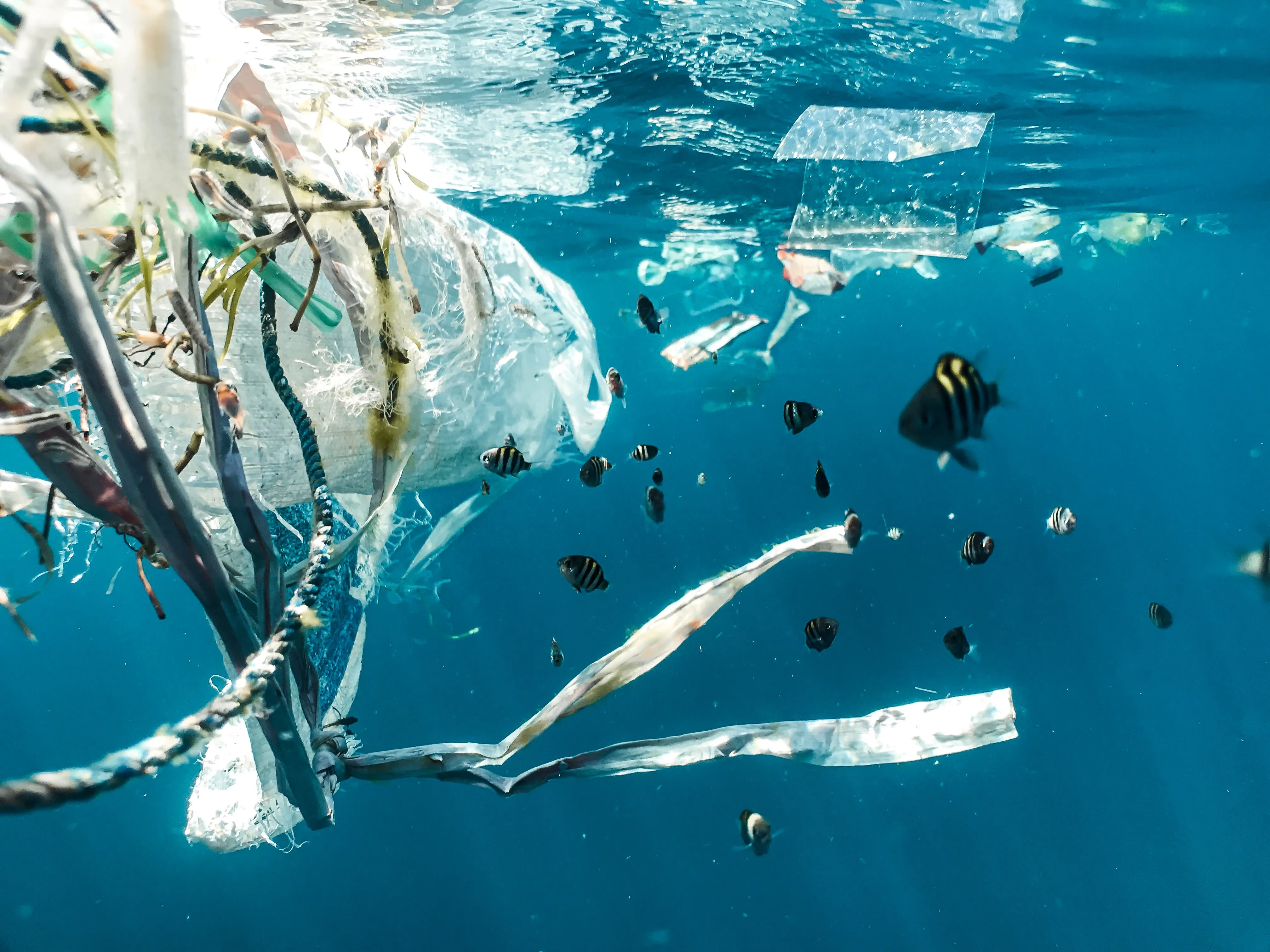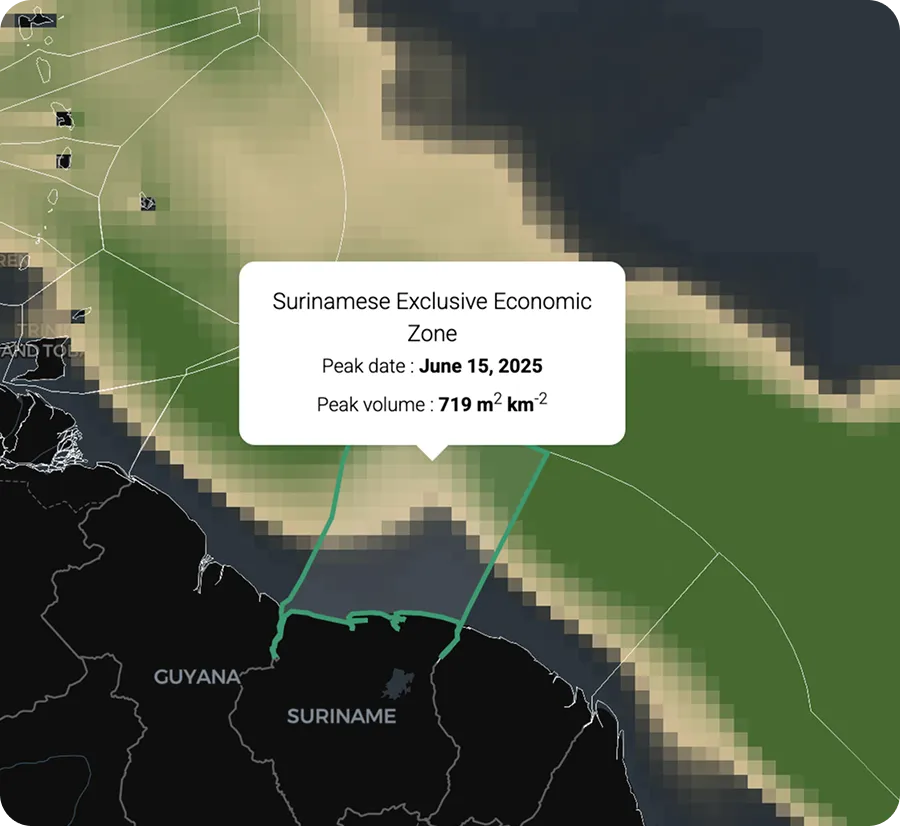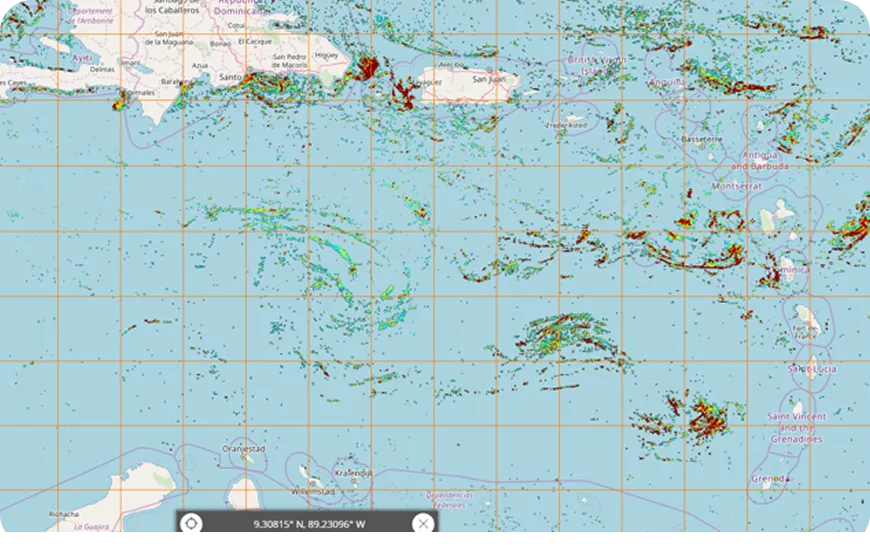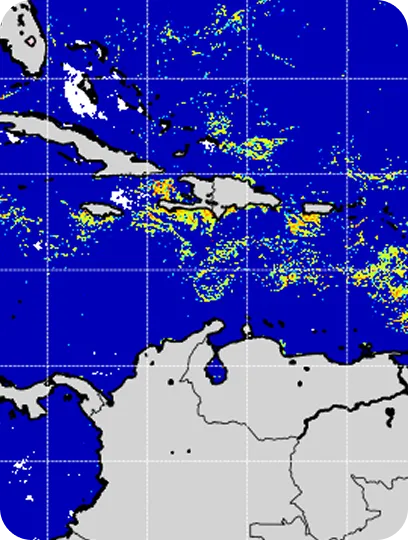The pervasive issue of marine litter has become a growing transboundary, multi-dimensional global concern profoundly impacting the health of our ocean with economic, environmental, cultural and human health risks and associated costs, as highlighted by the United Nations Environment Programme (UNEP).
As the volume of marine litter continues to escalate, the use of Earth observation has emerged as a crucial asset in facilitating research, mitigation and policy formulation to effectively combat this multifaceted challenge.
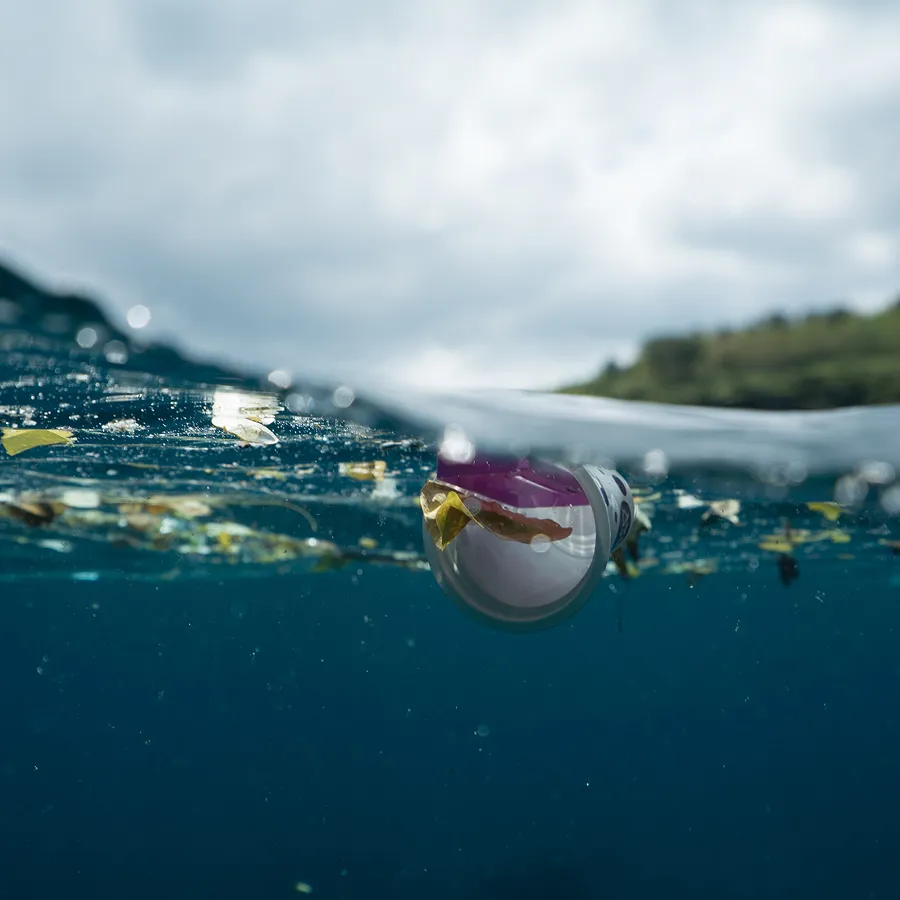
This dashboard/interactive page presents how Earth observation is crucial for the detection, monitoring, and forecasting of marine litter for informed action to combat marine plastic pollution. This information is necessary to inform prevention measures, mitigation strategies as well as monitor effectiveness of solutions aiming to maintain clean, healthy, productive and resilient marine ecosystems in line with the European Green Deal.
Description
Understanding the lifecycle of marine litter
Studies show that the majority of these items originates from land-based sources, such as industrial and transportation leaks, inadequate waste management practices, and the wear and tear of everyday items like tyres, clothing, etc. A recent study also highlights the major contribution of fishing gear in marine litter.
Marine litter is dispersed throughout the global ocean, spanning from the water's surface to the seabed and suspended at various depths within the water column. Marine litter is also abundantly found on coastlines such as sandy areas and mangroves. Coastal zones show higher concentrations, with high retention time close to locations where it originates. Once in the environment, litter gradually breaks down into smaller fragments down to nanoparticles due to exposure to UV radiation and mechanical forces.
The persistent presence of plastic in the marine environment and the ever-smaller size of its fragments allow it to enter the biosphere, impacting marine ecosystems. Marine litter poses a threat to marine life and potentially to human health by contaminating marine resources. Large objects cause entanglement and harbour invasive species, while smaller pieces, when ingested by marine animals, cause starvation but can also be vectors for pollutants and pathogens.
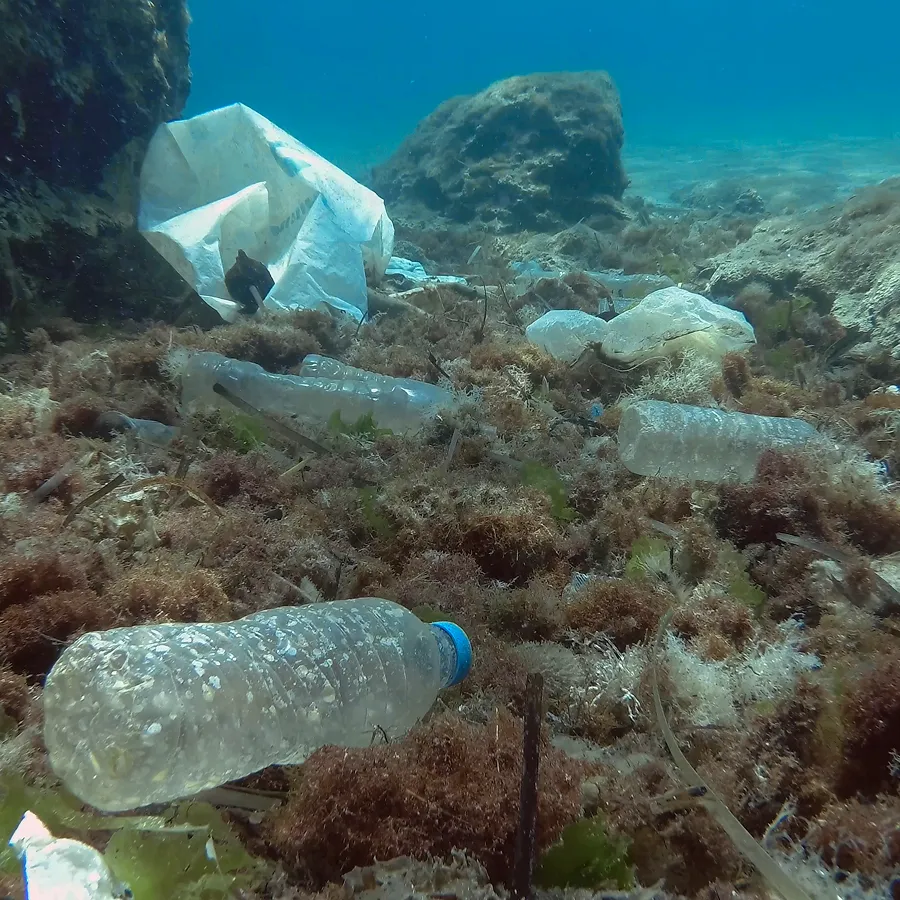
Impacts of marine litter
Targeting the way forward
As marine litter poses major risks, the need for global monitoring and reporting has been recognized by the United Nations (UN) by setting Sustainable Development Goal (SDG) target 14.1 on marine pollution, informed by a specific indicator on marine litter (14.1.1b) under the custody of UNEP. SDG 14.1 sets out as one of its targets to “by 2025, prevent and significantly reduce marine pollution of all kinds, from land-based activities, including marine debris and nutrient pollution”.
The way forward has been paved by the historic resolution (Resolution 14 of UNEA-5.2) endorsed by representatives from 175 nations at the 5th session of the United Nations Environment Assembly (UNEA-5) in March 2022. This resolution aims to end plastic pollution and forge an international legally binding instrument on plastic pollution, including in the marine environment by 2024, henceforth referred to as “Plastic Treaty”.
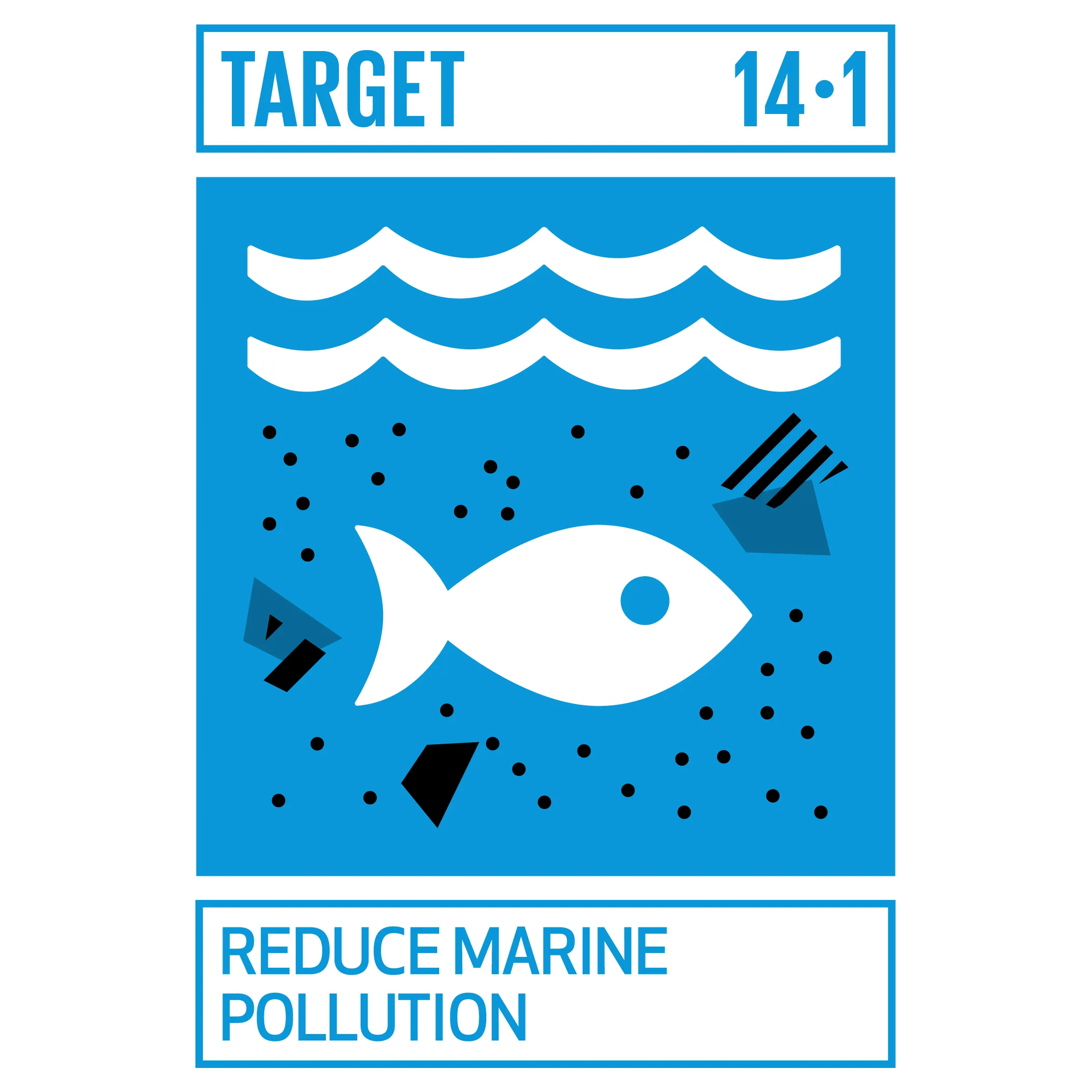
Still a long way to go
While numerous studies worldwide have focused on regional or large-scale anthropogenic debris pollution, a comprehensive approach to combat marine litter pollution is largely lacking.
Tackling marine litter pollution requires action across the plastic full lifecycle, including its production, design, and disposal and thus must consider many other SDGs (6, 11, 12, 15 and 17). Therefore, European strategies, including the Marine Strategy Framework Directive (MSFD) and the Intergovernmental Negotiating Committee developing the “Plastic Treaty” are addressing the entire lifecycle of marine litter pollution.
As a fundamental aspect of these efforts, monitoring the distribution of marine plastic and understanding its transportation pathways are essential to support the establishment of realistic targets for reducing plastic waste and to develop policies that effectively achieve these targets.
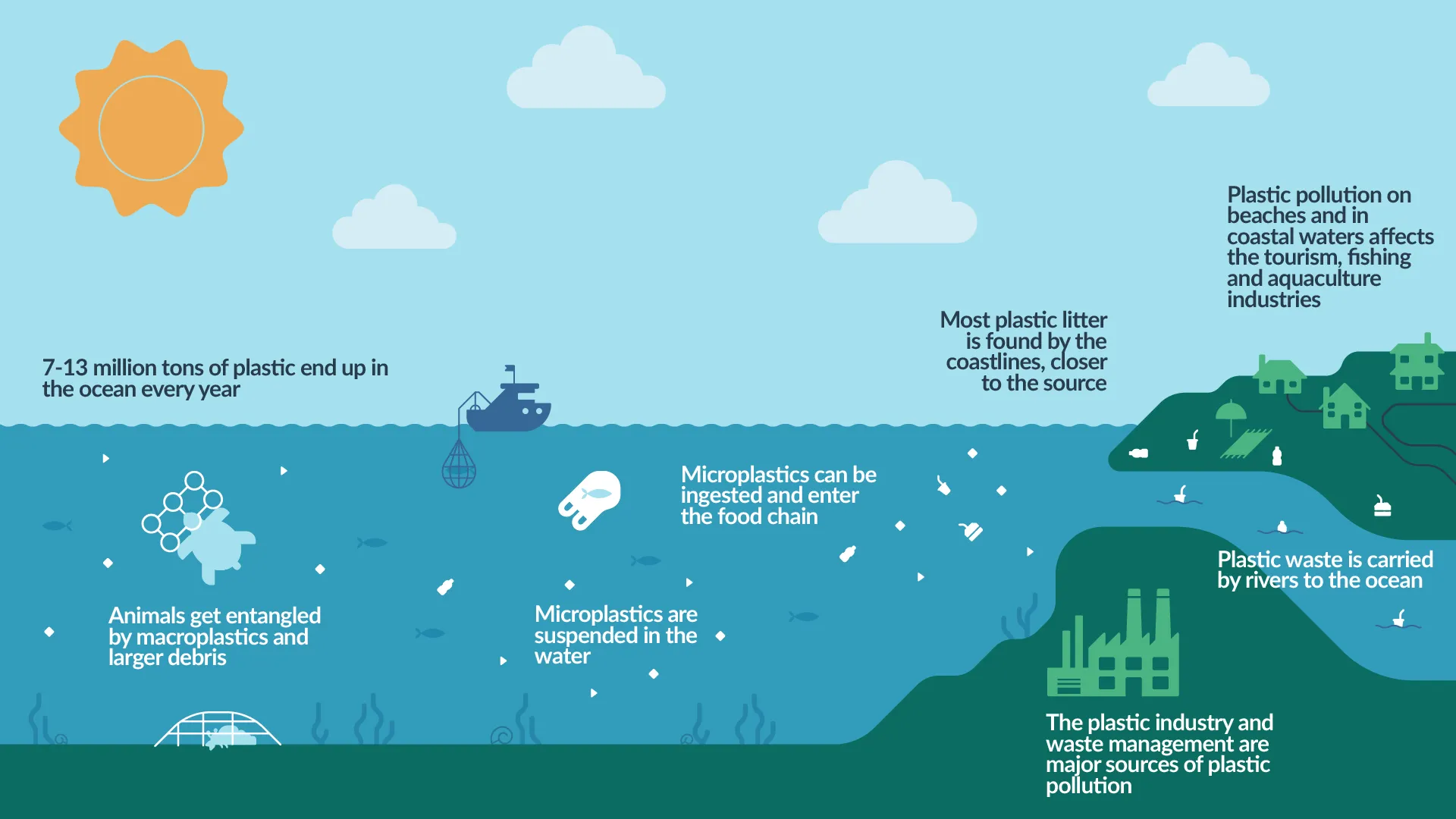
EU directives and strategies on marine litter
The European Union (EU) has implemented several directives and strategies aimed at addressing plastic pollution and monitoring marine litter across its member states.
To comply with these directives and strategies, European countries have established monitoring programmes, implemented measures to reduce plastic litter, and reported their progress and findings to the European Commission. This monitoring is crucial for assessing the effectiveness of policies, identifying areas needing improvement, and working towards reducing and managing marine plastic in European waters and beyond.
The EU’s Marine Strategy Framework Directive (MSFD) requires member states to develop marine strategies to achieve and maintain “good environmental status” in their marine waters. Monitoring and reducing marine litter is a key component of these strategies. Member states are obligated to establish monitoring programmes, assess the levels of marine litter, and take measures to reduce its impact.
The MSFD Technical Group on marine litter (TG Litter) is a platform for sharing technical information, facilitating discussions, and offering guidance within policy frameworks. It operates as a liaison between scientific research and policy implementation, enabling the exchange of information between research projects, scientists, European Commission services, experts from Member States, and Regional Sea Conventions (RSC). Through collaboration with RSCs, it engages in non-EU policy frameworks of shared marine waters. Additionally, the TG Litter supports EU’s global commitments, including G7, G20, and UN activities.
The EU Action Plan: Towards Zero Pollution for Air, Water and Soil, a key deliverable of the EU Green Deal, provides a compass to mainstream pollution prevention in all relevant EU policies, to step up implementation of the relevant EU legislation and to identify possible gaps.
The EU’s Single-Use Plastics Directive aims to reduce the impact of certain plastic products on the environment, particularly those found most often on European beaches, by imposing restrictions and setting reduction targets for single-use plastics. This directive also includes measures for monitoring the directive effectiveness and awareness-raising campaigns to tackle plastic pollution.
The EU’s Circular Economy Action Plan and the European Strategy for Plastics in a Circular Economy emphasise the importance of monitoring and reducing plastic litter to transition towards a circular economy, where plastics are used more sustainably, recycled, and their leakage into the environment is minimised.
Earth observation to help address challenges of marine litter
Earth Observation can be powerful in detecting, monitoring and forecasting marine litter to provide information on its sources, distribution and sinks, and to give insight on impacts and associated threats. Earth observation technologies encompass in situ measurements, satellite imagery, airborne remote sensing, and data analytics, including modelling.
The wealth of data provided by Earth observation supports in-depth research on marine litter dynamics and enables the modelling and forecasting of the litter distribution at the global scale.
This knowledge serves as a foundation for evidence-based policy design, but also is needed to assess the effectiveness of implemented directives and regulations, enabling adaptive management strategies. The visual evidence of marine litter pollution provided by Earth observation can furthermore foster public awareness, catalyse behaviour change, and mobilise collective action to curb the entry of litter into marine environments.
Detecting and monitoring marine litter
Various techniques are employed to measure and assess marine litter, falling in three categories:
In situ approaches
Rely on both sampling methods (trawls, booms, pumps, etc.) and analyses techniques (visual, chemical, etc). In situ observations provide sparse but critical ground truth information on abundance and distribution of marine litter in all dimensions and are vital to validate and improve remote sensing and simulated products.
Remote sensing technologies
Provide global surface observations but are limited by spatial resolution and revisit time (temporal resolution). Specific developments are in progress for the detection of marine litter.
Simulated products
Give access to continuous estimations in the four dimensions that can inform transportation pathways, sources and sinks of marine litter but rely on the representation of physical and chemical processes.
One common in situ method involves shoreline surveys, where researchers or citizen scientists systematically document and classify litter found along coastlines. In Europe, systematic surveys are conducted following the standardised guidelines for monitoring produced by the Oslo Paris (OSPAR) Commission, complementing the guidance document issued by the EC JRC report for the MSFD. This hands-on approach provides valuable insights into the types and quantities of litter deposited on shores.
Additionally, trawling nets, also called Manta nets, or remotely operated vehicles are utilised to collect litter from the sea surface, water column or seabed, allowing for sampling in different marine environments.
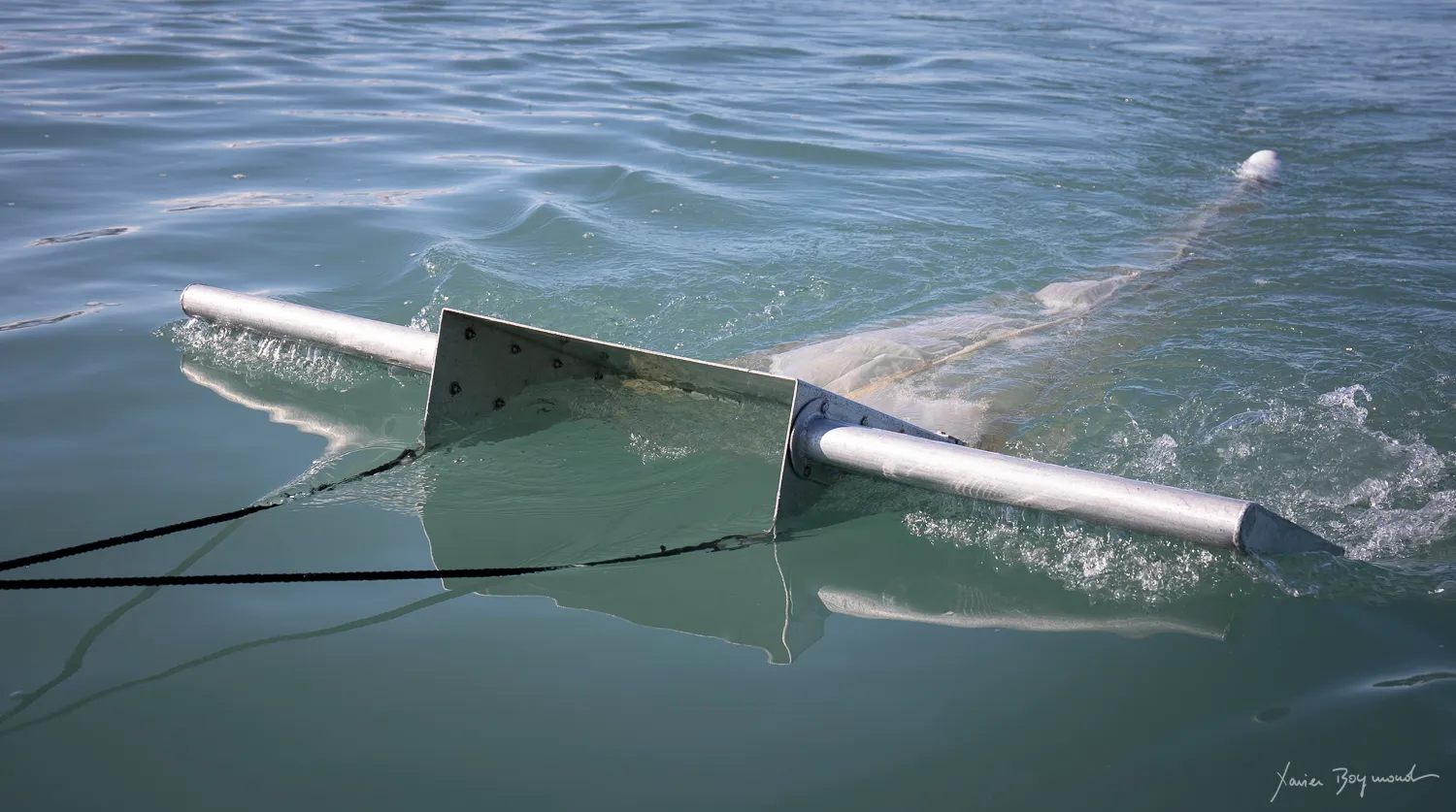
Measuring and assessing marine litter
Marine litter samples undergo various analytical methods to assess their composition, quantify their abundance, and understand their impact on the environment. Several techniques (Maximenko et al., 2019) are employed in analysing marine litter, including:
Visual classification
Initially, samples are visually inspected and categorised into different types of materials (plastics, glass, metal, etc.). This helps in understanding the main components of the litter.
Microscopy
Microscopic analysis aids in identifying smaller particles or fragments that might not be discernible through naked-eye observation. This includes identifying microplastics, which are plastic particles less than 5mm in size.
Chemical analysis
Chemical techniques like Fourier Transform Infrared Spectroscopy (FTIR) or Raman spectroscopy help in identifying the polymer composition of plastics. This analysis is crucial for understanding the types of plastics present in the samples.

Analysing marine litter
Innovative technological advancements in remote sensing have expanded measurement capabilities. Observations from satellites, planes and drones enable the mapping and analysis of larger oceanic areas to detect floating litter.
Remote sensing techniques play a pivotal role in providing valuable data for understanding and monitoring marine litter across vast oceanic areas, including:
Satellite imagery
High-resolution satellite observations provide information on large accumulations of floating debris, such as clusters of marine litter along frontal zones. Satellites equipped with multispectral or hyperspectral cameras can further identify and classify different types of floating debris based. Missions include Copernicus Sentinel 1 and 2, PRISMA and PlanetScope.
Aerial surveys
Utilising manned or unmanned aircrafts including drones equipped with specialised sensors or cameras enables the collection of high-resolution images for mapping and assessing coastal litter, particularly in hard-to-reach or remote areas.
Marine Litter geolocation, identification and density estimations from the Costal Marine Litter Observatory (CMLO)
Detection litter map
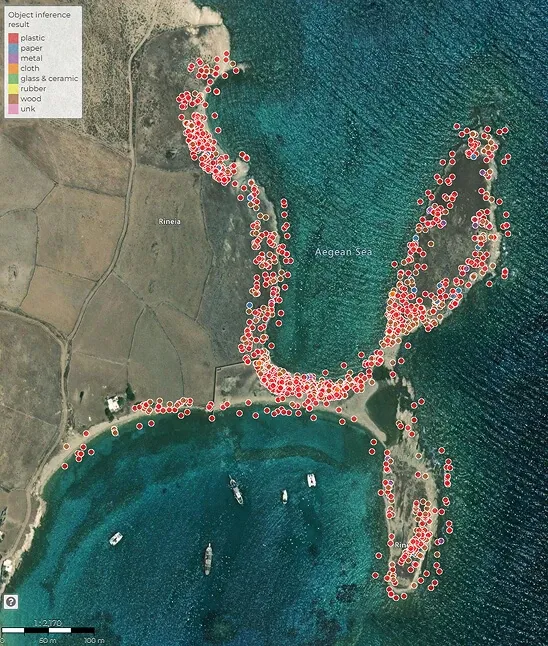
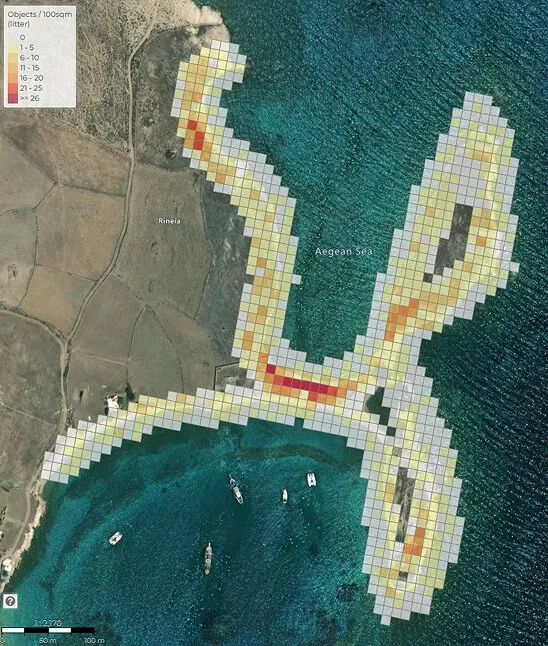
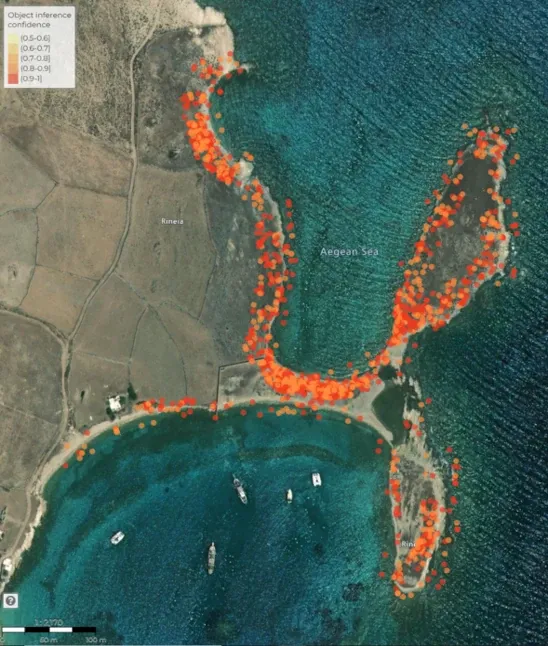
Remote sensing techniques
Simulating and forecasting marine litter
Finally, modelling marine litter is essential to simulate and predict the behaviour, distribution, and accumulation of litter in marine environments.
Transport and drift models simulate the movement of marine litter through ocean currents, wind patterns and tides. They consider factors like buoyancy, density, and degradation rates of different types of litter to predict their trajectories and accumulation areas. By a combination of Lagrangian particle tracking and numerical ocean circulation models, scientists simulate litter dynamics but can also explore different scenarios that enable the assessment of potential effectiveness of actions in reducing or preventing marine litter. They simulate the outcomes of different strategies, such as optimal litter removal, waste management improvements, directives and regulations, or behavioural interventions.
As monitoring is essential to detect changes in time and space, it requires repeated measurements and thus significant data gathering, analysis, and archiving. Effective monitoring requires providing suitable harmonised methods. Detecting, monitoring, and forecasting marine litter is a challenging task due to its complex nature. The diversity of marine litter types (different polymers with a variety of properties) and sizes ranging from large aggregations of fishing gear to nanoparticles invisible to the eye makes it unfeasible to establish one common measurement approach. In 2019 the GESAMP working group on marine litter proposed a first approach to the classification of marine litter and associated guidelines for monitoring.
Historically, measurements have been made at the research project level, providing data for a limited region and period, and parameters specific to the subject of research focusing on either physics, chemistry and/or biology. This has led to limited observations, coverage gaps, and uncertainties on sources, distribution and sinks of marine litter. Over the last decade, with marine litter becoming a more pressing issue, systematic surveys have been led by national governments and regional commissions such as the regional seas conventions or the European Commission.
More recently, the need for a globally coordinated and sustained observing system of marine debris to fill knowledge gaps and to address diverse stakeholder needs with adequate data and information has been raised. The Integrated Marine Debris Observing System (IMDOS) was established in 2019 and started implementation in 2023. It provides global coordination and guidance to lead the marine debris community in establishing a sustained global observing system and facilitating open access to data.
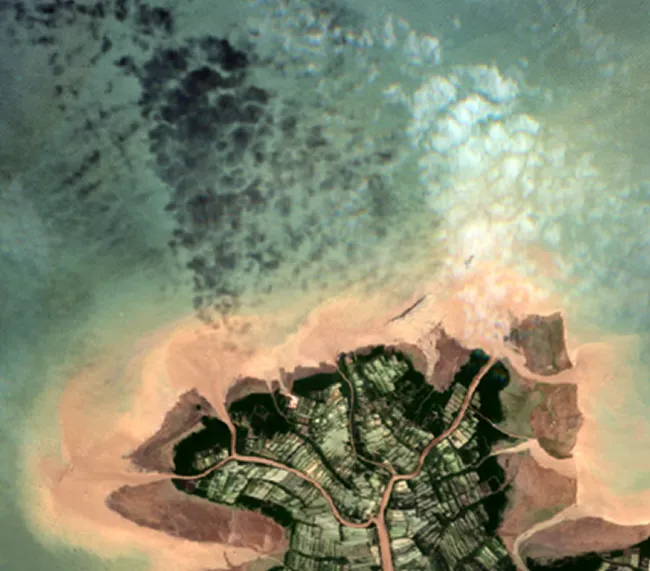
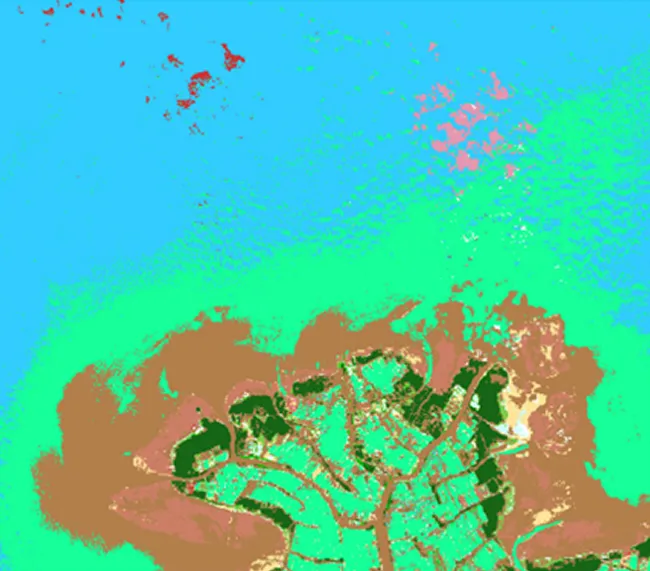
Satellite mission Copernicus Sentinel-2
True colour image (left) and classification from Lavender et al. (2022) methodology at the Solo River Mouth (Indonesia). Plastic is found offshore (red pixels).
Access to data and information on marine litter
The EU funds various data infrastructures, research and innovation projects, and other initiatives working to improve marine litter monitoring and forecasting and providing access to Earth observation-derived data and information on marine litter.
According to the “Portfolio Analysis” conducted under the EU Mission “Restore our Ocean and Waters by 2030”, at least 81 EU-funded research and innovation projects (on-going and terminated as of 2023) specifically address marine litter sources, transport, and distribution. Some are listed below:
Improving monitoring of marine litter
The Discovery Campaign on Remote Sensing of Plastic Marine Litter by ESA during 2020-2022 sought to inspire the creation of inventive solutions using data from the EU Space Programme. Its goal was to address issues regarding the identification, tracking, and elimination of microplastics, plastic waste, and larger debris in rivers, shores, and coastal areas. 26 innovative projects were undertaken to better map together the future of satellite imagery for marine litter. Projects included:
In November 2023, the Cassini Maritime Prize for Digital Space Applications awarded 3 grants supporting the development of space solutions to track and remove marine plastic pollution.
The Prize builds on the exploitation of the EU Space Programme which consists of several flagship programmes, including Copernicus, Galileo and EGNOS. This initiative aimed to engage innovative minds, attract private investment, and foster the development of practical solutions that are ready for the market. The awarded projects are:

Coastal and Marine Litter Observatory (CMLO)
Proposes a monitoring solution emerging from previous research at the University of the Aegean. Propelled by SciDrones, CMLO leverages cutting-edge drone technology and artificial intelligence for detecting and monitoring beach litters. CMLO detects and classifies automatically litter.

Eyes on Plastic
From EOMAP offers a web application relying on data including Sentinel-2 optical imagery, commercial satellite imagery and on-site cameras to detect, map, and continuously monitor plastic pollution in almost real-time. Its objective is to support governmental stakeholders in reporting and addressing marine.

Ocean Plastic Alert and Tracking (OPAT)
Developed by GEOMATYS. By integrating ocean currents and wind models with satellite data, this application aims to identify sea debris and anticipate its movement patterns. This product will enable coastal authorities to foresee debris accumulation following severe weather events posing navigational hazards and support mitigation actions.
Remote sensing
Besides the in situ monitoring done by EU member states as required by the MSFD, several projects provide in situ measurements of marine litter done by institutional and citizen scientists.
Harmonising in situ observations remains a challenge to be addressed. The 15 partners of EUROqCHARM project aim to establish harmonised methodologies for in situ monitoring and assessment of macro-, micro-, and nanoplastics in the environment, as well as blueprints for standards and recommendations for European policy and legislation.

On ships of opportunity by the CLAIM project.

AI Smart Camera
Attached on a Robotic Seabed Cleaning Platform by the MAELSTROM project.

State-of-the-art autonomous surface vehicle
Capable of launching remotely operated vehicles that map and sample surface and seabed litter.
In situ
The Tracking Of Plastic In Our Seas (TOPIOS) project was dedicated to research for tracking plastic movement through the ocean and understand and/or simulate fragmentation, sinking, beaching, wave-mixing and ingestion by biota. The project developed tools such as the oceanparcels.org to create customisable particle tracking simulations, including plastic, using output from ocean circulation models.
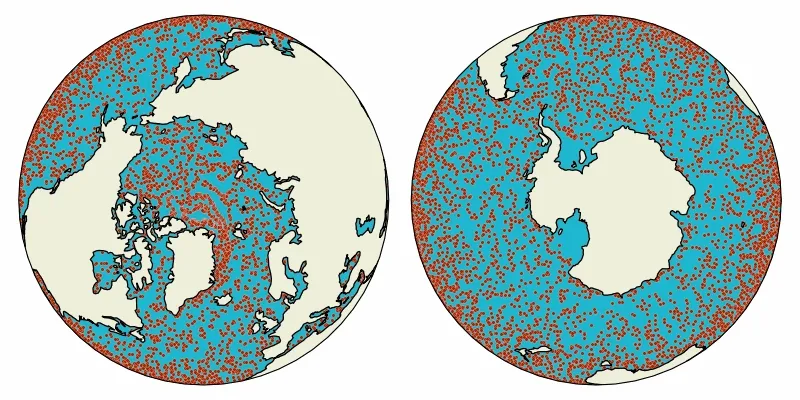
EDITO-Model Lab project is building the underlying model suite for the European Digital Twin of the Ocean, including a focus application on marine plastics. The application aims to simulate the pathways of plastics — for example, originating from rivers and coastal areas — once they reach the ocean, with information on where the plastic comes from, where it will accumulate, and how long it takes to get there.
With this application, users will be able to create their own what-if scenarios to simulate, tailor, and test different management actions, such as specific beach cleaning plans or measures to reduce plastic pollution linked to any river in the world. The European Union Digital Twin of the Ocean will provide decision-support tools for managers, policymakers, citizens, blue economy sectors and other actors of society on plastic tracking.
Modelling
Current databases and services
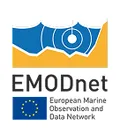
The European Marine Litter Database (MLDB), was created by EMODnet Chemistry based on recommendations from the MSFD Technical Group on Marine Litter. It was developed in close collaboration with key stakeholders within the EU, including the EC JRC, Regional Seas Conventions, EU Member States, and the International Council for the Exploration of the Sea (ICES). This database encompasses data for beach and seafloor macro litter, as well as floating and sediment micro litter.

Database on the Marine Environment (DOME) supported by ICES is used by the OSPAR and HELCOM Regional Sea Conventions and the Arctic Monitoring & Assessment Programme (AMAP) in the management of chemical and biological data for regional marine assessments following specific monitoring programme guidelines.

LITTERBASE hosted by the Alfred Wegener Institute, gathers data from 3,071 scientific studies on the amount, distribution and composition of litter in the ocean and other watercourses. Users can access information through a global map or infographics. This web application also provides a publication search tool.

The EU’s Copernicus DataSpace provides access to all Copernicus Sentinel Missions datasets. The Copernicus Data Space Ecosystem supports users in accessing, viewing, using, downloading, and analysing satellite data at low processing levels. Sentinel missions low processing level data are essential for marine litter detection algorithms.
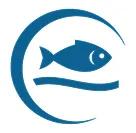
The EU’s Copernicus Marine Service offers free and unrestricted access to a wealth of processed and quality-controlled satellite (high processing levels), in situ, and modelled data products that can be leveraged to detect, monitor, model, and forecast marine litter. These data provide essential information: wind, waves, and surface ocean currents transport marine debris to the first order and eddies and density fronts determine the finer scale distribution. For examples of applications, see the marine litter use cases.
EU mission
Restore our ocean and waters by 2030
Established under the Horizon Europe programme for the years 2021-2027, and launched in 2021, the EU Mission 'Restore our Ocean and Waters' seeks to safeguard and restore the well-being of our ocean and water bodies by 2030. This initiative involves research and innovation, active participation of citizens, and fostering investments in the blue economy.
The Mission supports regional engagement and cooperation through area-based ‘Lighthouses' sites to pilot, demonstrate, develop and deploy the Mission activities across EU seas and river basins.
BlueMissionMED is working on the implementation of the Lighthouse in the Mediterranean basin to prevent and eliminate pollution of our ocean, seas, and waters, focusing on marine litter.
Some supported projects are dedicated to preventing and removing litter, plastics, and microplastics from our waters. Additionally, they aim to decrease marine litter and pollution by implementing smart and environmentally friendly fishing gear with minimal impact.
Initiatives and international coordination for combatting marine litter
The Integrated Marine Debris Observing System \(IMDOS\) provides coordination and guidance to lead the marine debris community in establishing a sustained global observing system and facilitating open access to data.
An initiative of GEO Blue Planet, and UNEP GPML, IMDOS has been endorsed as a GOOS (Global Ocean Observing System) project.
IMDOS brings together representatives of international groups including those described here:

The UNEP Global Partnership on Plastic Pollution and Marine Litter (GMPL) serves as a collaborative platform enabling experts and stakeholders to exchange knowledge, tools, and resouces. Additionally, it facilitates the identification of gaps and emerging issues. The primary goal is to contribute towards the 2030 Agenda, specifically targeting SDG 14.1. Specific objectives include: reducing the leakage of plastics into the ocean through improved design; the application of the ‘3Rs’ principle (reduce, re-use, recycle); encouraging ‘closed-loop’ systems and more circular production cycles; and maximisation of resource efficiency and minimisation of waste generation.

GESAMP Working Group 40 on “Sources, Fate and Effects of plastics and micro-plastics in the marine environment”. Its focus moved from the state-of-the-art knowledge on micro and macro plastics (2012-2014) to adding recommendations (2015-2016) to providing the international community definitions and guidelines for monitoring (2017-2020) and finally on risk assessment covering social, economic and environmental impacts (2020-2023).
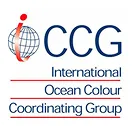
International Ocean Colour Coordinating Group (IOCCG) Task Force on Remote Sensing of Marine Litter and Debris: the primary objective is to facilitate the progress of existing and upcoming remote sensing technologies and methods that can potentially gather data on plastic litter in all aquatic environments.
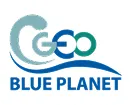
GEO Blue Planet Marine Litter Working Group led by its EU Office with EU funding via the EU4OceanObs project, collaborates with a network of experts and existing programs to facilitate the development and use of Earth Observations for the benefit of society. It supports the establishment of IMDOS strategy and implementation plan. Their efforts focus in particular in fostering cooperation and co-design so that the tools developed meet information needs of stakeholders.

Scientific Committee on Oceanic Research (SCOR) Floating Litter and its Oceanic TranSport Analysis and Modelling (FLOTSAM) focuses on tackling the issue of floating plastic pollution through a combination of on-site research, modelling, and remote sensing techniques. This integrated approach has evolved into a widely accepted method. Their key publications have now become fundamental in the scientific understanding of marine litter, influencing significant decisions in this scientific domain.
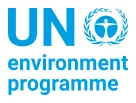
Regional Seas Conventions including four concerning European waters (OSPAR, HELCOM, Barcelona and Bucharest) provide inter-governmental frameworks to address the degradation of the oceans and seas at a regional level including pollution from marine litter. They provide regional assessment of state of plastic pollution and provide guidance and recommendations on monitoring and actions to undertake.

UN International Atomic Energy Agency (IAEA) NUclear TEChnology for Controlling Plastic Pollution (NUTEC) flagship initiative brings together 63 countries participating in marine litter monitoring by equipping over 50 labs worldwide with the technology and know-how required to sample and analyse marine microplastics in the oceans, and to enable reporting on SDG 14, Life Under Water.
Earth observation based Marine Litter monitoring & forecasting value chain
Sampling
- Sampling through manta trawls, pumps and UAVs
- Sample analysis (chemical analysis, etc)
- Sampling through manta trawls, pumps and UAVs
- Sample analysis (chemical analysis, etc)
Sampling 
Remote sensing
Sensors on satellites, planes and drones:
- Radar data
- Optical data
- Hyperspectral data
- Backscatter data
EU Copernicus Satellites: Sentinels 1, 2 & 3
Sensors on satellites, planes and drones:
- Radar data
- Optical data
- Hyperspectral data
- Backscatter data
EU Copernicus Satellites: Sentinels 1, 2 & 3
Remote sensing 
Data
Ocean observations are processed and originate ocean data products to be used in modelling
Ocean observations are processed and originate ocean data products to be used in modelling
Data 
Need for In situ observations
In situ observations are essential to calibrate satellite products for plastic detection and improve validation and accuracy of numerical models
- Global in situ observations to provide ground truth estimate of marine litter distribution
- Harmonisation of sampling and analysis methodologies
- Coordinated and sustained observations
- Standardised and interoperable data
In situ observations are essential to calibrate satellite products for plastic detection and improve validation and accuracy of numerical models
- Global in situ observations to provide ground truth estimate of marine litter distribution
- Harmonisation of sampling and analysis methodologies
- Coordinated and sustained observations
- Standardised and interoperable data
Need for In situ observations 
Analysis
Outputs from satellite observations help create a detection algorithm (model)
Outputs from satellite observations help create a detection algorithm (model)
Analysis 
Predictive modelling
Ocean and atmosphere dynamics, environmental conditions and plastic are described by numerical to create:
- Meteorological observations forecast and modelling (wind, waves)
- Input estimates from river discharge, extreme events (floods, tsunamis) and atmospheric deposition
- Hydrodynamic modelling
- Numerical drift & decay (fragmentation, beaching, sinking, biota interaction) models
Ocean and atmosphere dynamics, environmental conditions and plastic are described by numerical to create:
- Meteorological observations forecast and modelling (wind, waves)
- Input estimates from river discharge, extreme events (floods, tsunamis) and atmospheric deposition
- Hydrodynamic modelling
- Numerical drift & decay (fragmentation, beaching, sinking, biota interaction) models
Predictive modelling 
Models are also informed by marine litter detection algorithms that generate information such as:
- Marine litter geolocation
- Marine litter type identification
- Marine litter density estimation
These models generate information such as:
- Marine litter sources and sinks
- Marine litter pathways
- Marine litter 4D density estimation
Models are also informed by marine litter detection algorithms that generate information such as:
- Marine litter geolocation
- Marine litter type identification
- Marine litter density estimation
These models generate information such as:
- Marine litter sources and sinks
- Marine litter pathways
- Marine litter 4D density estimation
Products and services
Both observations and numerical modelling are the backbone of:
- Baseline global estimation of distribution and variability
- Monitoring and forecasting visualisation platforms and tools
- Decision-support tools for mitigation and policy making
Both observations and numerical modelling are the backbone of:
- Baseline global estimation of distribution and variability
- Monitoring and forecasting visualisation platforms and tools
- Decision-support tools for mitigation and policy making
Products and services 
End user benefits
Challenges and gaps in detecting, monitoring and forecasting marine litter
To assess the influence, distribution, and quantity of marine litter on the environment and the effectiveness of mitigation measures and waste management strategies, it is crucial to establish a baseline and define thresholds for policymaking and other decision-making processes. Despite advancements, gaps persist:
Recommendations
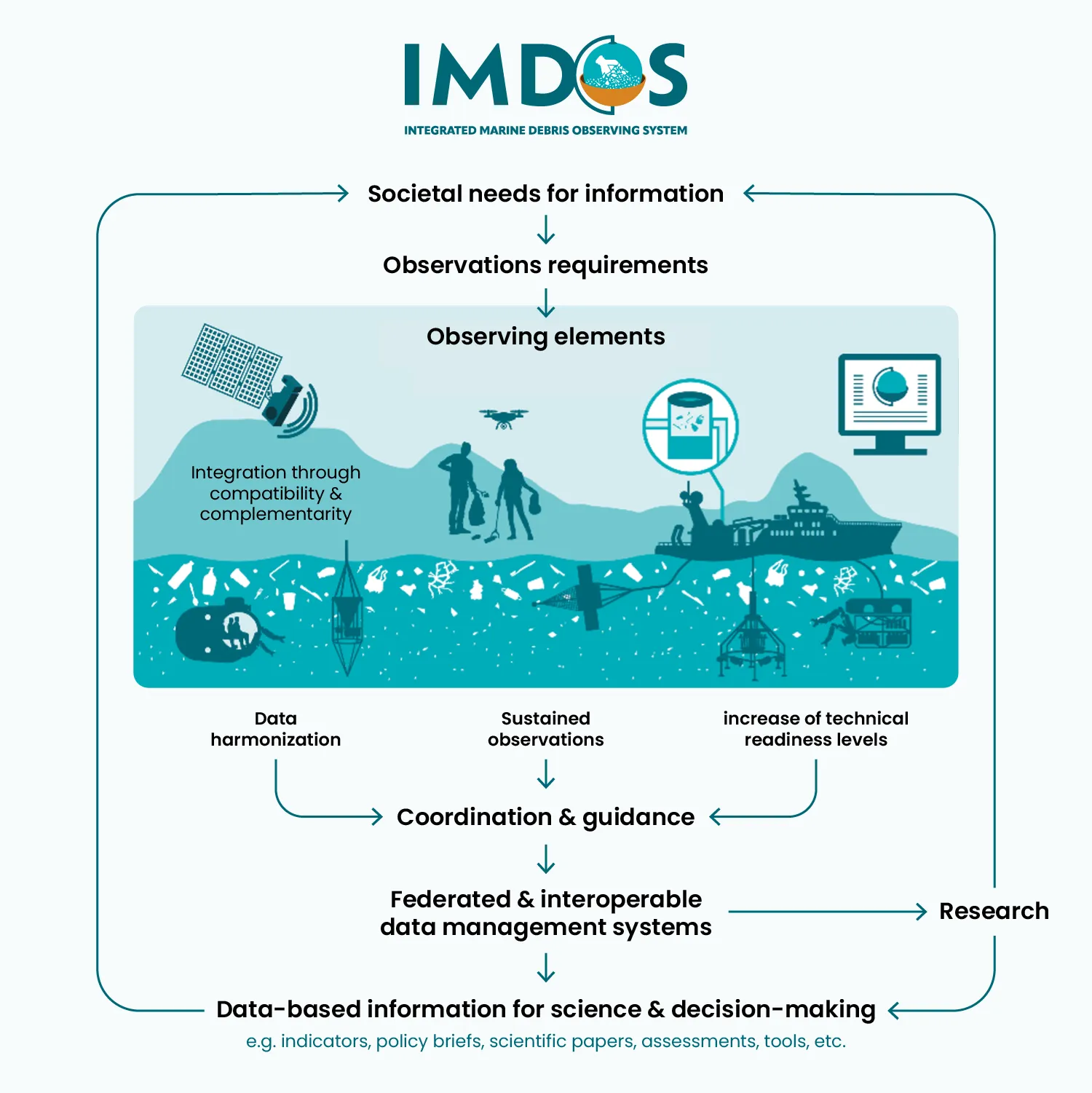
Coordination
A global and integrated marine debris monitoring system is critical to enable scientists to assess marine plastic pollution true extent and provide informed guidance for effective actions including setting targets and develop, implement, and adjust policies.
In particular, standardising data collection and analyses methodologies as well as data compatibility will ensure uniformity, essential for research and monitoring.
As a vital instrument, the Integrated Marine Debris Observing System (IMDOS) aims to integrate a globally coordinated and sustained marine debris monitoring framework that will facilitate long-term global monitoring for the benefit of research and informed decision making.
Technical
Additionally, fostering collaborative research among the scientific community and other stakeholders as well as investing in innovative technologies for real-time monitoring will become pressing. These recommendations collectively amplify the necessity of marine litter observation, supporting more informed decisions.
Investment
Additionally, fostering collaborative research among the scientific community and other stakeholders as well as investing in innovative technologies for real-time monitoring will become pressing. These recommendations collectively amplify the necessity of marine litter observation, supporting more informed decisions.
Biermann, L., Clewley, D., Martinez-Vicente, V. et al. (2020). Finding Plastic Patches in Coastal Waters using Optical Satellite Data. Scientific Reports, 10, 5364. https://doi.org/10.1038/s41598-020-62298-z
Borrelle et al. (2020). Predicted growth in plastic waste exceeds efforts to mitigate plastic pollution. Science, 369(6510), 1515–1518. https://doi.org/10.1126/science.aba3656
Cheshire, A.C., Adler, E., Barbière, J., Cohen, Y., Evans, S., Jarayabhand, S., Jeftic, L., Jung, R.T., Kinsey, S., Kusui, E.T., Lavine, I., Manyara, P., Oosterbaan, L., Pereira, M.A., Sheavly, S., Tkalin, A., Varadarajan, S., Wenneker, B., & Westphalen, G. (2009). UNEP/IOC Guidelines on Survey and Monitoring of Marine Litter. UNEP Regional Seas Reports and Studies, No. 186; IOC Technical Series No. 83.
Dalberg Advisors, & WorldWide Fund of Nature - WWF Mediterranean Marine Initiative. (2019). Stop the Flood of Plastic: How Mediterranean countries can save their sea.
Delandmeter, P., & van Sebille, E. (2019). The Parcels v2.0 Lagrangian framework: new field interpolation schemes. Geosci. Model Dev., 12, 3571–3584. https://doi.org/10.5194/gmd-12-3571-2019
Duncan, E.M., Arrowsmith, J., Bain, C., Broderick, A.C., Lee, J., Metcalfe, K., Pikesley, S.K., Snape, R.T.E., van Sebille, E., & Godley, B.J. (2018). The true depth of the Mediterranean plastic problem: Extreme microplastic pollution on marine turtle nesting beaches in Cyprus. Marine Pollution Bulletin, 136, 334-340. https://doi.org/10.1016/j.marpolbul.2018.09.019
Evans, M. C. & Ruf, C. S. (2022). Toward the Detection and Imaging of Ocean Microplastics With a Spaceborne Radar. IEEE Transactions on Geoscience and Remote Sensing, 60, 1-9. https://doi.org/10.1109/TGRS.2021.3081691
GESAMP. (2019). Guidelines or the monitoring and assessment of plastic litter and microplastics in the ocean (Kershaw P.J., Turra A. and Galgani F., editors), (IMO/FAO/UNESCO-IOC/UNIDO/WMO/IAEA/UN/UNEP/UNDP/ISA Joint Group of Experts on the Scientific Aspects of Marine Environmental Protection). Rep. Stud. GESAMP No. 99, 130p.
Jalón-Rojas, I., Wang, X.H., & Fredj, E. (2019). A 3D numerical model to Track Marine Plastic Debris (TrackMPD): Sensitivity of microplastic trajectories and fates to particle dynamical properties and physical processes. Marine Pollution Bulletin, 141, 256-272. https://doi.org/10.1016/j.marpolbul.2019.02.052
Kaandorp, M.L.A., Lobelle, D., Kehl, C. et al. (2023). Global mass of buoyant marine plastics dominated by large long-lived debris. Nature Geoscience, 16, 689–694. https://doi.org/10.1038/s41561-023-01216-0
Kehl, C., Nooteboom, P.D., Kaandorp, M.L.A., & van Sebille, E. (2023). Efficiently simulating Lagrangian particles in large-scale ocean flows — Data structures and their impact on geophysical applications. Computers & Geosciences, 175, 105322. https://doi.org/10.1016/j.cageo.2023.105322
Lavender, S. (2022). Detection of Waste Plastics in the Environment: Application of Copernicus Earth Observation Data. Remote Sensing, 14(19), 4772. https://doi.org/10.3390/rs14194772
Lusher, A. L., & Primpke, S. (2023). Finding the balance between research and monitoring: When are methods good enough to understand plastic pollution? Environmental Science & Technology, 57(15), 6033-6039. https://doi.org/10.1021/acs.est.2c06018
Matthias, S., Devriese, L. I., Booth, A. M., De Witte, B., Everaert, G., Gago, J., Galgani, F., Langedock, K., Lusher, A., Maes, T., Pirlet, H., Russell, J., & Pham, C. K. (2023). A systematic review of state-of-the-art technologies for monitoring plastic seafloor litter. Journal of Ocean Engineering and Science. https://doi.org/10.1016/j.joes.2023.07.004
Maximenko, N., Corradi, P., Lavender Law, R., van Sebille, E., Garaba, S.P., Lampitt, R.S. et al. (2019). Towards the Integrated Marine Debris Observing System. Frontiers in Marine Science. https://doi.org/10.3389/fmars.2019.00447
Morales-Caselles et al. (2021). An inshore–offshore sorting system revealed from global classification of ocean litter. Nature Sustainability, 4(6), 484-493. https://doi.org/10.1038/s41893-021-00720-8
Newman, S., Watkins, E., Farmer, A., Brink, P., & Schweitzer, J. P. (2015). The economics of marine litter. In Bergmann, M., Gutow, L., & Klages, M. (Eds.), Marine Anthropogenic Litter. Springer, Cham. https://doi.org/10.1007/978-3-319-16510-3_14
Publications Office of the EU. (2013). Guidance on monitoring of marine litter in European seas. https://doi.org/10.2788/99475
Ruiz-Orejón, L.F., Tornero, V., Boschetti, S.T., & Hanke, G. (2021). Marine Strategy Framework Directive - Review and analysis of EU Member States’ 2018 reports - Descriptor 10: Marine litter. EUR 30665 EN, Publications Office of the European Union, Luxembourg. https://doi.org/10.2760/238367
Schreyers, L., van Emmerik, T., Biermann, L., & van der Ploeg, M. (2022). Direct and Indirect River Plastic Detection from Space. In IGARSS 2022 - IEEE International Geoscience and Remote Sensing Symposium, Kuala Lumpur, Malaysia, 5539-5542. https://doi.org/10.1109/IGARSS46834.2022.9883379
Sherman, P. & Sebille, E. (2016). Modeling marine surface microplastic transport to assess optimal removal locations. Environmental Research Letters, 11. https://doi.org/10.1088/1748-9326/11/1/014006
Tekman, M. B., Walther, B. A., Peter, C., Gutow, L., & Bergmann, M. (2022). Impacts of plastic pollution in the oceans on marine species, biodiversity and ecosystems. WWF Germany. https://doi.org/10.5281/zenodo.5898684
Ter Halle, A., Jeanneau, L., Martignac, M., Jardé, E., Pedrono, B., Brach, L., Gigault, J. (2017). Nanoplastic in the North Atlantic subtropical gyre. Environmental Science & Technology, 51(23), 13689-13697. DOI: 10.1021/acs.est.7b03667
Topouzelis, K., Papageorgiou, D., Suaria, G., & Aliani, S. (2021). Floating marine litter detection algorithms and techniques using optical remote sensing data: A review. Marine Pollution Bulletin, 170, 112675. https://doi.org/10.1016/j.marpolbul.2021.112675
UN Environment. (2017). Marine Litter Socio Economic Study. United Nations Environment Programme, Nairobi, Kenya.
United Nations Environment Programme. (2021). From Pollution to Solution: A global assessment of marine litter and plastic pollution. Nairobi.
United Nations Environment Programme. (2021). Drowning in Plastics – Marine Litter and Plastic Waste Vital Graphics.
Van Sebille, E., Aliani, S., Law, K. L., Maximenko, N., Alsina, J. M., Bagaev, A., Bergmann, M., Chapron, B., Chubarenko, I., Cózar, A., Delandmeter, P., Egger, M., Fox-Kemper, B., Garaba, S. P., Goddijn-Murphy, L., Hardesty, B. D., Hoffman, M. J., Isobe, A., Jongedijk, C. E., ... Wichmann, D. (2020). The physical oceanography of the transport of floating marine debris. Environmental Research Letters, 15(2), Article 023003. https://doi.org/10.1088/1748-9326/ab6d7d
Vighi, M., Ruiz-Orejón, L. F., Hanke, G. (2022). Monitoring of Floating Marine Macro Litter – State of the art and literature overview. EUR 31073 EN, Publications Office of the European Union, Luxembourg. https://doi.org/10.2760/78914
References
Open
